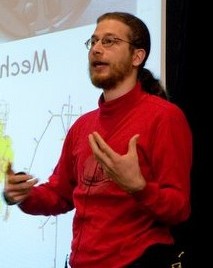|
October
12 -4:30 p.m
Sidney Smith Hall, 100 St. George St., Room 2117
Algorithms Meet Art, Puzzles, and Magic
When I was six years old, my father Martin Demaine and I
designed and made puzzles as the Erik and Dad Puzzle Company,
which distributed to toy stores across Canada. So began our
journey into the interactions between algorithms and the arts
(here, puzzle design). More and more, we find that our mathematical
research and artistic projects converge, with the artistic
side inspiring the mathematical side and vice versa. Mathematics
itself is an art form, and through other media such as sculpture,
puzzles, and magic, the beauty of mathematics can be brought
to a wider audience. These artistic endeavors also provide
us with deeper insights into the underlying mathematics, by
providing physical realizations of objects under consideration,
by pointing to interesting special cases and directions to
explore, and by suggesting new problems to solve (such as
the metapuzzle of how to solve a puzzle). This talk will give
several examples in each category, from how our first font
design led to building transforming robots, to how studying
curved creases in origami led to sculptures at MoMA. The audience
will be expected to participate in some live magic demonstrations.
October
13 -- 11:00 a.m.
Fields Institute, Room 230
Linkage Folding: From Erdös to Proteins
Linkages have a long history ranging back to
the 18th century in the quest for mechanical conversion between
circular motion and linear motion, as needed in a steam engine.
In 1877, Kempe wrote an entire book of such mechanisms for
"drawing a straight line". (In mathematical circles,
Kempe is famous for an attempted proof of the Four-Color Theorem,
whose main ideas persist in the current, correct proofs.)
Kempe designed many linkages which, after solidification by
modern mathematicians Kapovich, Millson, and Thurston, establish
an impressively strong result: there is a linkage that signs
your name by simply turning a crank.
Over the years mathematicians, and more recently computer
scientists, have revealed a deep mathematical and computational
structure in linkages, and how they can fold from one configuration
to another. In 1936, Erdös posed one of the first such
problems (now solved): does repeatedly flipping a pocket of
the convex hull convexify a polygon after a finite number
of flips? This problem by itself has an intriguingly long
and active history; most recently, in 2006, we discovered
that the main solution to this problem, from 1939, is in fact
wrong.
This talk will describe the surge of results about linkage
folding over the past several years, in particular relating
to the two problems described above. These results also have
intriguing applications to robotics, graphics, nanomanufacture,
and protein folding.
October
14 -- 11:00 a.m.
Fields Institute, Room 230
Geometric Puzzles: Algorithms and Complexity
I love geometry because the problems and solutions
are fun and often tangible. Puzzles are one way to express
these two features, and are also a great source of their own
computational geometry problems: which puzzles can be solved
and/or designed efficiently using computer algorithms? Proving
puzzles to be computationally difficult leads to a mathematical
sort of puzzle, designing gadgets to build computers out of
puzzles. I will describe a variety of algorithmic and computational
complexity results on geometric puzzles, focusing on more
playful and recent results.
Erik D. Demaine is an professor of Computer Science at the
Massachusetts Institute of Technology. His Ph.D. dissertation,
a seminal work in the field of computational origami, was
completed at the University of Waterloo. This work was awarded
the Canadian Governor General's Gold Medal from the University
of Waterloo and the NSERC Doctoral Prize, 2003, for the best
Ph.D. thesis and research in Canada (one of four awards).
In 2003 he was awarded a MacArthur Fellowship. He joined the
MIT faculty in 2001, at age 20, reportedly the youngest professor
in the history of the Massachusetts Institute of Technology.
He is a member of the Theory of Computation group at MIT Computer
Science and Artificial Intelligence Laboratory. Mathematical
origami artwork by Erik and Martin Demaine was part of the
“Design and the Elastic Mind” exhibit at the Museum
of Modern Art in 2008 and has been included in the MoMA permanent
collection.
|

